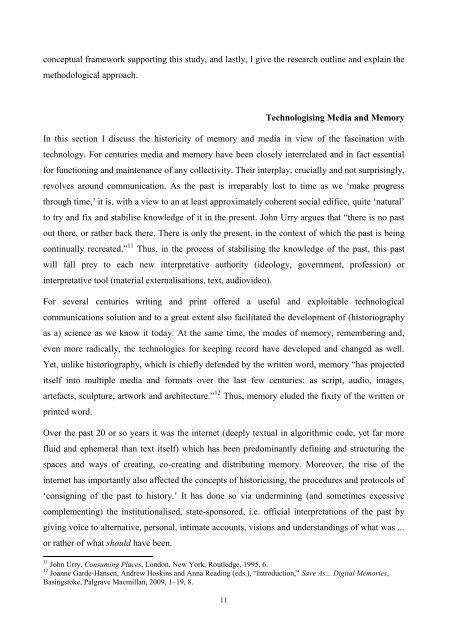UNIVERSITY OF NOVA GORICA GRADUATE SCHOOL ...
UNIVERSITY OF NOVA GORICA GRADUATE SCHOOL ...
UNIVERSITY OF NOVA GORICA GRADUATE SCHOOL ...
Create successful ePaper yourself
Turn your PDF publications into a flip-book with our unique Google optimized e-Paper software.
conceptual framework supporting this study, and lastly, I give the research outline and explain the<br />
methodological approach.<br />
11<br />
Technologising Media and Memory<br />
In this section I discuss the historicity of memory and media in view of the fascination with<br />
technology. For centuries media and memory have been closely interrelated and in fact essential<br />
for functioning and maintenance of any collectivity. Their interplay, crucially and not surprisingly,<br />
revolves around communication. As the past is irreparably lost to time as we ‗make progress<br />
through time,‘ it is, with a view to an at least approximately coherent social edifice, quite ‗natural‘<br />
to try and fix and stabilise knowledge of it in the present. John Urry argues that ―there is no past<br />
out there, or rather back there. There is only the present, in the context of which the past is being<br />
continually recreated.‖ 11 Thus, in the process of stabilising the knowledge of the past, this past<br />
will fall prey to each new interpretative authority (ideology, government, profession) or<br />
interpretative tool (material externalisations, text, audiovideo).<br />
For several centuries writing and print offered a useful and exploitable technological<br />
communications solution and to a great extent also facilitated the development of (historiography<br />
as a) science as we know it today. At the same time, the modes of memory, remembering and,<br />
even more radically, the technologies for keeping record have developed and changed as well.<br />
Yet, unlike historiography, which is chiefly defended by the written word, memory ―has projected<br />
itself into multiple media and formats over the last few centuries: as script, audio, images,<br />
artefacts, sculpture, artwork and architecture.‖ 12 Thus, memory eluded the fixity of the written or<br />
printed word.<br />
Over the past 20 or so years it was the internet (deeply textual in algorithmic code, yet far more<br />
fluid and ephemeral than text itself) which has been predominantly defining and structuring the<br />
spaces and ways of creating, co-creating and distributing memory. Moreover, the rise of the<br />
internet has importantly also affected the concepts of historicising, the procedures and protocols of<br />
‗consigning of the past to history.‘ It has done so via undermining (and sometimes excessive<br />
complementing) the institutionalised, state-sponsored, i.e. official interpretations of the past by<br />
giving voice to alternative, personal, intimate accounts, visions and understandings of what was ...<br />
or rather of what should have been.<br />
11 John Urry, Consuming Places, London, New York, Routledge, 1995, 6.<br />
12 Joanne Garde-Hansen, Andrew Hoskins and Anna Reading (eds.), ―Introduction,‖ Save As... Digital Memories,<br />
Basingstoke, Palgrave Macmillan, 2009, 1–19, 8.

















